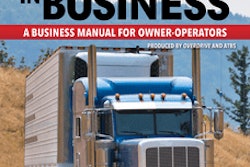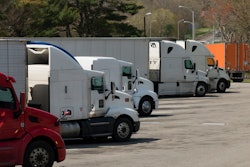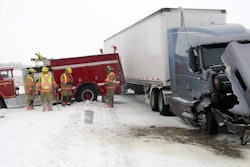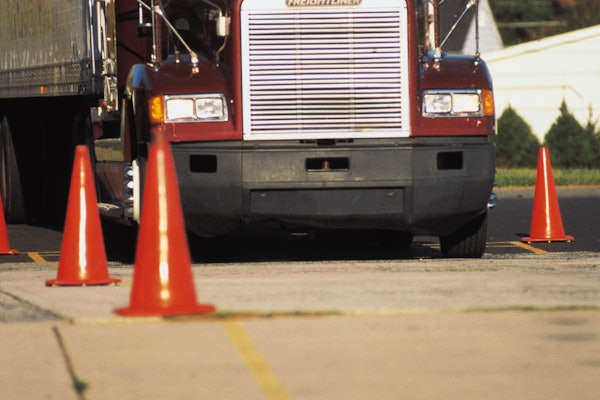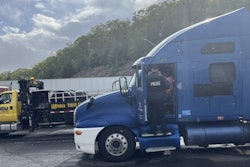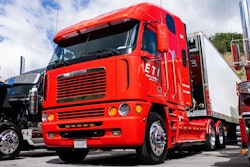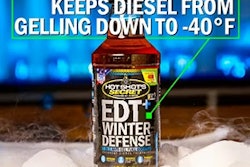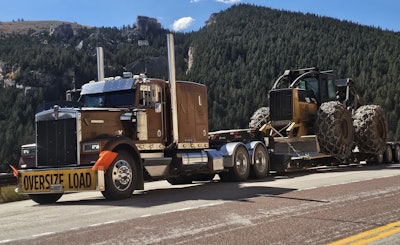
The greater investment and specialization a job requires, the better the pay, right? To the owner-operators and small fleets who've weathered the rates storm in freight the last several years, it might not feel like that’s the case. But for small fleet owners and owner-operators in the specialized oversize/heavy-haul trucking, it mostly holds true.
Hauling loads for $12-$14 a mile or even higher isn’t out of the ordinary in the niche, but there's plenty cost-wise that goes into those rates:
- Specialized trailer equipment built to haul high, wide and ugly freight can cost four times or more a garden variety van/flatbed.
- Permits are often required, too.
- Pilot car/escort services, more insurances in some cases -- all drive rates for the specialized niche higher with more hands in the proverbial cookie jar.
Competition is generally less intense than in other freight markets, but when those markets crash, you can bet there will somebody trying to haul specialized freight cheaper.
“A few years ago it was good, and then it seems like everybody wants to get into heavy-haul,” said small fleet owner Kevin Hunter. “Everyone wants to be the guy moving the big stuff. And there’s people getting in the heavy-haul that don’t have a … clue what they should be charging” to haul.
Hunter is the owner of 24-truck, Bentleyville, Pennsylvania-based Hunter Contracting LLC. He’s been in business since 2013 and moves heavy equipment for local dealerships and construction companies.
 Hunter hauls plenty oversized construction equipment with his 24-truck fleet, headquartered near Pittsburgh. He bought and customized this 2024 Kenworth W900L when he found out the model was going to be discontinued after 2025. Hunter does the dispatching for his fleet, but when he does jump in a truck to work, this is the one he drives currently. It's hooked to a tri-axle Talbert capable of hauling up to 60 tons.
Hunter hauls plenty oversized construction equipment with his 24-truck fleet, headquartered near Pittsburgh. He bought and customized this 2024 Kenworth W900L when he found out the model was going to be discontinued after 2025. Hunter does the dispatching for his fleet, but when he does jump in a truck to work, this is the one he drives currently. It's hooked to a tri-axle Talbert capable of hauling up to 60 tons.
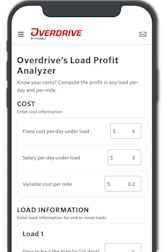
Gary Jones, owner of Lawson, Missouri-based SPB Trucking, said $12-14/mile is a pretty standard rate for his operation, “but we’re spending $3 a mile in escorts and a dollar a mile in permits. You start dropping all that off of it,” and the rate that actually goes to the carrier falls quick, he said.
Similarly, Pottstown, Pennsylvania-based Walt Stearly, owner of Stearly's Motor Freight, noted accessorial costs add up quick with oversize freight.
“We try and get at least five bucks a mile, and that’s just for the truck,” he said. “Then if you’re gonna factor in escorts ... they’re charging in the neighborhood of three bucks a mile per car. So, if you need two, now you’re six bucks a mile for the escorts, five bucks a mile for the truck. It doesn’t take long to figure out that 11 bucks a mile is an ugly number if you’re going 3,000 miles.”
 Small fleet owner Stearly owns three trucks as part of his Stearly Motor Freight heavy/oversize-haul business. He typically drives either this 1993 Freightliner cabover or a 2008 Kenworth himself, and he has a driver in a 1997 Freightliner that he also owns. Operating mostly on the East Coast, he said the cabover is a big help on overlength loads when going into the tighter cities.
Small fleet owner Stearly owns three trucks as part of his Stearly Motor Freight heavy/oversize-haul business. He typically drives either this 1993 Freightliner cabover or a 2008 Kenworth himself, and he has a driver in a 1997 Freightliner that he also owns. Operating mostly on the East Coast, he said the cabover is a big help on overlength loads when going into the tighter cities.
Stearly’s trips don’t often take him as far as that -- he tries to stay east of the Mississippi River to ensure both his trucks are readily available for customers. Yet the point stands. It takes a hefty rate to make it in the heavy/oversize world. Add to that the fact that “backhauls” generally don’t exist because the equipment is so specialized.
“You have to price it that you’re coming back empty,” Stearly said. “You’re just not going to find something that’s right there coming back towards the East Coast for a steer dolly," like the one pictured above with Stearly's cabover that allows for better maneuverability with overlength loads. "I’m not gonna say it never happens -- it’s happened maybe six times in my 40 years doing this. It’s not very often.”
Big profits can accrue to small fleets and owner-ops with knowledge sufficient to do business in the heavy/oversize niche and do it well. But that knowledge doesn't always come easy, either. Beyond hard costs, it's important to know the ins and outs of the business before jumping in to learn on the fly.
Sometimes, there's no better teacher than experience.
Learning the ropes: Knowing what it takes informs the rates
 SPB Trucking owner Gary Jones operates this 2018 Peterbilt 389, "Triple Seven," doing heavy-haul work across the U.S. His nine-truck fleet has 16 trailers of varying sizes and weight limits. Most of the work SPB does is at a gross weight at or under 150,000 pounds.
SPB Trucking owner Gary Jones operates this 2018 Peterbilt 389, "Triple Seven," doing heavy-haul work across the U.S. His nine-truck fleet has 16 trailers of varying sizes and weight limits. Most of the work SPB does is at a gross weight at or under 150,000 pounds.
It’s difficult enough to manage a standard 80,000-pound, 8.5-foot-wide rig riding down the highway at 65-70 mph without having any issues. There’s a reason truck drivers are required to hold the licenses they do, after all. Expand the width by a few feet and add some (or a whole lot of) additional weight: the challenge ratchets up.
As in many a specialized trucking niche, owner-operators who aspire to oversize and/or heavy-haul business ownership would do well to gain experience either as a company driver or leased.
For Walt Stearly’s line of work -- hauling overhead cranes -- he said prospective owner-ops might go to work for a “mobile crane company that has a couple of trucks that they haul their own counterweights and their own this, their own that, somewhere they can tie down, untie, move some oversized stuff and be, I say, somewhat protected,” as he put it. Having somebody “holding their hand a little bit at the beginning” until they’re comfortable with the work and what it entails.
Maybe you’re an owner-operator who already has some flatbed and step deck experience, but you haven’t crossed into the bigger and heavier freight yet. “Make sure you have good equipment. Make sure that you’re partnering up with a good carrier that’s going to have your back,” said Gary Jones.
With the cost of more specialized equipment, insurance, permits, pilots, plus the risk involved in having bigger equipment on the crowded highways, “the risk costs money, and if you’re taking the risk, you’ve got to be paid for it,” Jones added. “If not, you can go hook to a reefer,” and probably make less money but also not have as much risk involved.
Jones has observed an influx of operators in recent years, “and they’re just killing us on rates because they think that $5/mile is great," he said. Why? "They’re used to making $2/mile. And at the end of the day, they say, ‘$5/mile, that’s awesome.’ Well, no, no it’s not. When you don’t understand the actual cost of doing things,” it hurts the whole industry.
Too many new operators in the business don’t consider the equipment needed to do the work, Jones added. “They’re driving a Cascadia pulling a three-axle low boy, and they’re putting 72-74,000 pounds on deck and not realizing that everything they have is overloaded and overworked. It’s not very safe. And they can do it for less than me because I’m not running equipment like that. I’m running double-framed trucks that are built to do what we do.”
Gillette, Wyoming-based Jason Chamberlain, owner of Action Hotshot Service LLC (since starting the company he’s moved from hotshot to pulling with a 1985 Kenworth W900B) harkened the old adage of going slow and steady.
“Don’t try to jump from a flatbed to 13 axles," he said. "Your life’s gonna be miserable." Go slow, "lease on to a company that has lighter RGN trailers, lighter equipment. Get a feel for it, get a feel for how to properly chain things down.”
A lot of Chamberlain's work is in the oil fields. Some of the oil companies require $5 million in liability insurance to haul their freight -- added insurance of course means added expense for oversize/heavy-haul operators.
Instead of the standard $100,000 in cargo insurance, Chamberlain's required to carry a minimum of $500,000 in cargo. He also carries $2 million in general liability “with a $2 million aggregate and a $2 million umbrella as well.”
Gary Jones' fleet carries $2 million in cargo insurance. “It varies per customer” in terms of what they want, he said. “John Deere wants you to carry $1.5 million if you’re going to get any of their stuff that’s over X, Y and Z as far as dimensions. ... So you’re better off just getting a bunch of insurance to cover you and your customers and pay the premium, and pass it along.”
Permits, pilots, police escorts
 Jason Chamberlain's '85 W900B hauls a wide range of equipment, including excavators, loaders and more for the BNSF railroad and other customers.
Jason Chamberlain's '85 W900B hauls a wide range of equipment, including excavators, loaders and more for the BNSF railroad and other customers.
Permitting requirements and costs for oversize and overweight loads vary state to state. One-truck owner-operator Chamberlain said he mostly handles his own permits for loads going through Wyoming, Montana, the Dakotas, New Mexico, Colorado and Texas. When he gets past South Dakota heading east, though, he uses a permitting service.
Verifying the details of any permit is crucial. When Chamberlain gets one he's careful to fully read through it to ensure he follows the correct route and does everything he’s required to do -- slowing down to cross bridges or other state-by-state and route-by-route requirements.
Too many operators “just get [permits] and roll, and then they have problems,” Chamberlain said. Big mistake, particularly if you get off route and hit a low bridge. Mind the details. "If there’s three pages, I’ll read all three pages. I don’t want to get in a bind with the law enforcement, but I also don’t want to buy a bridge, either."
Within the permits from the states will be the laws the operator has to follow -- “they tell you what you need, what you can and can’t do, daylight hours, whatever,” Chamberlain added. “So just reading the permit, you can learn a lot.”
Some states -- Chamberlain gave Colorado as an example -- sell an annual permit that “covers pretty much for anything you’re gonna haul unless it’s real big,” he said. But even with that annual permit in hand, you still have to coordinate with the state on every haul to ensure a specific route doesn’t have construction ongoing or any other issues that would require an alternate route.
“You actually have to bid your route,” Chamberlain said of Colorado’s system. “You’ve got to go on the computer, put in the route you want to go, and it’ll tell you whether or not you can go that route.” If you get the go-ahead, “you have to print that out, and it’s good for 24 hours and you have to have that in your possession. So, I mean, there’s little things like that that can really bite you if you’re not paying attention to the rules on the permits.”
 Stearly's 2008 Kenworth W900 is shown here hooked to what he described as a mobile power substation used by a power company. The load weighed in around 175,000 pounds and just barely made the cut on height for hauling on the Pennsylvania Turnpike.
Stearly's 2008 Kenworth W900 is shown here hooked to what he described as a mobile power substation used by a power company. The load weighed in around 175,000 pounds and just barely made the cut on height for hauling on the Pennsylvania Turnpike.
Gary Jones and SPB Trucking have a family connection with a permitting expert -- his sister runs a permitting company, and they work closely on hauls for his nine-truck fleet. “She stays up on the latest and greatest of the regulations and rules," Jones said, and "keeps all of us moving in a timely manner.”
Jones echoed Chamberlain on the importance of following the requirements on the permits. “You can’t go crossing a weight-limited bridge at 60 miles an hour because you’ll damage the bridge and it won’t last,” he said. “Follow your permit, do what they say. And you know, the motoring public, they don’t really think and take that kind of stuff into consideration. They’re just cussing and honking and flipping you off, and they have no idea that you’re just trying to do what you’re supposed to do the right way.”
Each state also has rules on when a pilot car is needed. As discussed above, the cost of those pilot cars eat into the driver’s rate. Chamberlain said he’s experienced having to hire a pilot just to cross a single bridge.
When a police escort is required, it can get even more challenging. Jones noted that police departments often charge by the hour and by the rank of the officer providing the escort, “so you never know what it’s going to be. If you call and you got to get a police escort, you might get a rookie that costs you $125 an hour, and then next time you call, you might get the sergeant. He’s $300 an hour.”
It's important to do the leg work on a load before you accept a rate given the many variables in costs to haul it. “Call and find out what it’s going to cost," Jones said, communicating any potential variance in escort cost, for instance, with the shipper.
Sometimes, a permitting service may be required, said owner-operator Walt Stearly. While he tries to do as much of his permitting as he can himself, sometimes a permitting service is unavoidable -- such as when going to New York City, he noted.
Access more feature reporting around a bevy of trucking niches via Overdrive's Niche Hauls archive.


